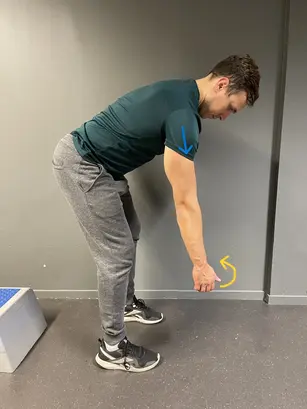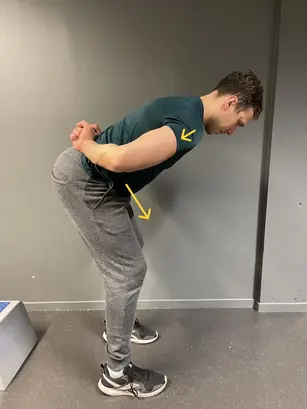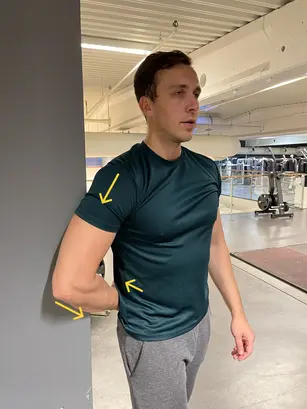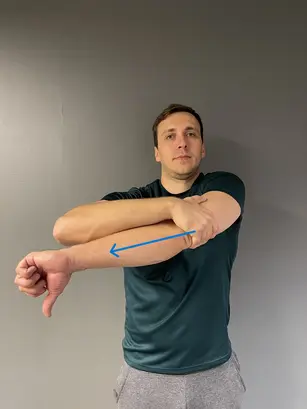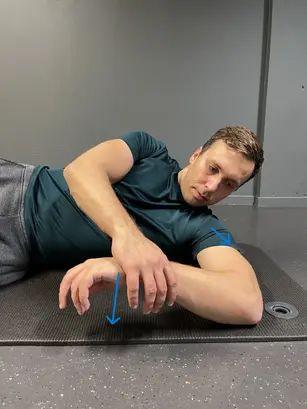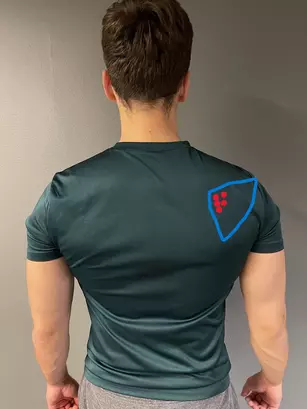Best Infraspinatus Stretches for Rotator Cuff Flexibility And Shoulder Mobility
In this article I will show you the best infraspinatus stretches for improving shoulder flexibility and reducing a shoulder pain caused by rotator cuff muscle, infraspinatus.
Best Infraspinatus Stretches for Shoulder
Pendulum Stretch
- From a standing position, bend your upper body slightly forward
- Let your arm “hang” freely, placing your shoulder in a gentle traction
- Make circles with your hand, without activating any muscle in your shoulder
- Repeat 10 times in both directions
This is a basic infraspinatus stretch that’s great for relieving the tension in the shoulder capsule and promoting a better range of motion, especially with a frozen shoulder.
Standing Bent-Over Infraspinatus Stretch
- From a standing position, bend over your upper body and place your hands behind your back
- While holding your hands firmly on your back, push with your elbows forward
- Make sure you depress your shuolders
- Hold for 30s
This is one of the most popular infraspinatus stretches because you can stretch both shoulders at the same time.
Wall Infraspinatus Stretch
- Place one hand behind your back and place your arm/elbow on a wall
- Lower your shoulder as much as you can before stretching infraspinatus
- Then, lean backward with your body, placing your shoulder into internal rotation
- Find the appropriate stretching intensity and hold for 30s
This is the most effective way to stretch infraspinatus because you can easily change the intensity of a shoulder stretch.
Broom Assisted Infraspinatus Stretch
- While holding a broom/stick with your both hands (one hand is behind your back)
- Lift the stick up with your upper hand until you experience a gently stretching in the opposite shoulder
- Hold this stretch for 30s
Cross-arm Stretch
- Place your arm into a internal rotation (thumb facing down) and pull your arm to the opposite side
- Hold this position for 30s
Sleepers Stretch Infraspinatus
- Lay down on your side
- Place your arm in 90/90 position (shoulder and elbow flexion)
- With a help of other hand, push your forearm towards the floor
- Focus on not lifting your shoulder from a ground
- Hold this stretch for 30s
Sit on Heal Infraspinatus Stretch
- Start by sitting on a heal position
- Cross your arms
- Extend your arm to the opposite side as much as you can, while pulling your shoulder-blade towards your spine
- Hold this position for 30s
How to Release Infraspinatus with Massage Ball
To release infraspinatus muscle you should place a massage ball on a medial part of infraspinatus and gently lean with your body toward the ball. The best way to do infraspinatus release if from lying on your back. Then you want to perform active shoulder internal rotation while massaging your infraspinatus with a ball. Perform this technique for 1-2min before and/or after stretching.
How to Tell if You Have Tight Infraspinatus
Infraspinatus act as a external rotator in shoulde joint, which means if you can’t rotate internally your shoulder for around 70 to 90 degrees, then you might have a tight infraspinatus muscle.
Additionally, active trigger points in infraspinatus often give pain in a mid-thoracic area, weakness when holding arm up and/or pain when stretching infraspinatus through internal shoulder rotation.
Importance of Infraspinatus for Shoulder and Back
Infraspinatus is a part of a rotator cuff muscles. Those muscles play a huge role in maintaining a functional, painfree and strong shoulders. You use rotator cuff muscles when you rotate your arms (which is a lot of activities) but they’re also act as a active stabilizators (while ligaments are passive stabilizators) of a shoulder joint.
So, rotator cuff muscles should be both flexible and strong in order for you to operate with full potential with your shoulders.
Another important fact is posture. Infraspinatus and teres minor are one of a few muscles (beside rhomboid) that combat rounded shoulders posture. If they are weak and inactive, then you have a greater chances of having a rounded shoulder posture (thoracic kyphosis).
Benefits of Infraspinatus Stretching
Stretching Infraspinatus can reduce shoulder pain, improve ROM (range of motion) in your shoulder, especially internal rotation of a shoulder.
Since the infraspinatus helps stabilize the humerus head during arm movements, having a fully functional infraspinatus (including stretching) makes any arm movement easier and safer for a shoulder.
With safer shoulder movements, I refer to one of the most common shoulder problems, the shoulder impingement syndrome. Tightness in the infraspinatus leads to reducing the subacromial space and make your shoulder tendons of rotator cuff muscles prone to weakness due to impingement in subacromial area.
To summarize, with infraspinatus stretching you will:
- Improve shoulder flexibility, especially internal rotation
- Improve shoulder blade mobility, the lower part of scapula
- Reduce muscle pain in shoulder
- Prevent shoulder impingement syndrome
- Make activities that involve holding your arm up a lot easier and safer for your shoulder
Tips When Stretching Infraspinatus Muscle
- Do not lift your shoulder while stretching infraspinatus muscle
- Instead of lifting your shoulders, focus on depressing your shoulders downward before stretching
- Hold every static stretch for 30s max
- If you experience pain when stretching, stop immediately and consult your healthcare provider for next step
- Ideally, you want to both stretch and strengthen infraspinatus muscle.
Conclusion
The importance of infraspinatus at shoulder joint is huge. This muscle both actively rotate externally shoulder and stabilize the head of a humerus when lifting your arm up. That makes infraspinatus active in almost everything you do with your arms. Occasionally, infraspinatus can become tight and painful (active trigger points) so stretching infraspinatus is a great way to combat that tightness and create a more functional environment around shoulder joint. One of the best infraspinatus stretches are wall internal rotation of shoulder, cross-arm stretch and floor stretch.

